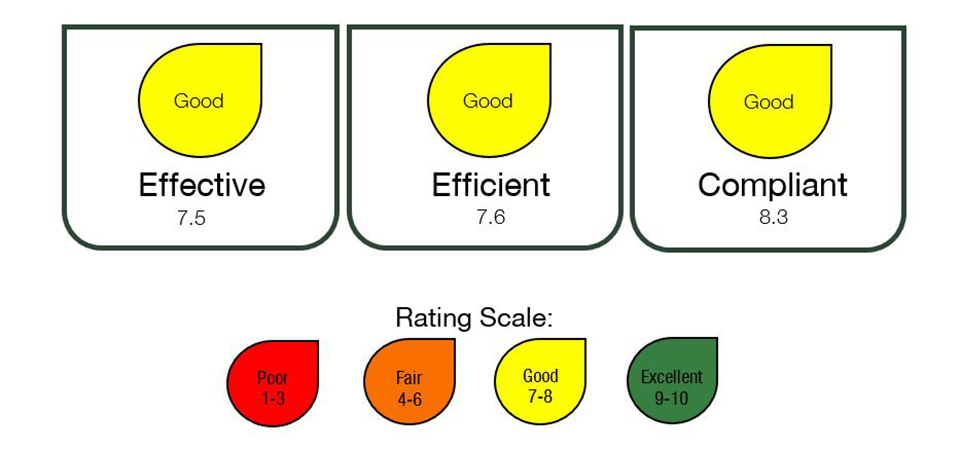Continuous improvement program - 2021-2022 Annual report
Annual evaluation
Twenty-four randomly selected impact assessments (IA) are evaluated each year to see how well they meet the Effective, Efficient and Compliant expected results of the Parks Canada Directive on Impact Assessment.

-
Long text description
Representation of the results of the 2021-2022 Annual Evaluation, according to a rating scale where poor scores are from 1 to 3, fair scores are from 4 to 6, good scores 7 to 8 and excellent are from 9 to 10. The results are good (7.5) in the Effective category, good (7.6) in the Efficient category and good (8.3) in the Compliant category.
Highlights:
- Expected Results are achieved overall. Particular strengths identified in choosing the appropriate IA pathway and maintaining high policy compliance.
- Examples of conservation and cultural resource gains were identified. An excellent example was the incorporation of green technologies, ecological design, and reduced infrastructure footprint into a backcountry shelter redevelopment project. This served to improve visitor experience, reduce maintenance and operation requirements, and maintain or improve ecological and cultural integrity.
- 50% of the IAs received Excellent ratings.
- Areas for improvement include quality of Basic Impact Assessments (BIA) and efficiency in filling out IA pathway decision forms.
Key recommendations:
- Develop and deliver training on how to write Impact Assessment reports (in progress).
- Incorporate micro-learning opportunities into IA Community of Practice communications and planning.
- Consult with the IA Community of Practice to inform update of the BIA template to address gaps and improve clarity in BIA reports.
Key investigation
The topic of the 2021-22 Key Investigation was IA Process. This includes legislative and policy obligations relating to IA and the project management process which contributes to the Effective and Compliant Expected Results. The Key Investigation included an additional in depth review of the 24 selected IAs focusing on nine key indicators. This included a survey, one-on-one interviews and follow-up questions on certain responses for additional information.
Highlights:
- Expected Results achieved for 6 out of the 9 indicators and many successes identified. These successes include: all projects were compatible with Parks Canada policy and mandate, there were opportunities for IA to influence the project at different stages, mitigations were included in permits, contracts and approvals for all applicable projects, work did not commence until the IA process was complete for all projects, expenditure of funds did not occur until after the IA was completed, all projects were posted on the required tracking systems and the majority of projects had a complete project file.
- Areas for improvement include: engaging IA Practitioners early to inform project design, identifying IA costs in the project budget, and sharing follow-up results.
Key recommendations:
- Consult with the IA Community of Practice to assess efficacy of existing IA tools to inform project design.
- Conduct an investigation into follow-up monitoring process and best methods to share results.
- Date modified :